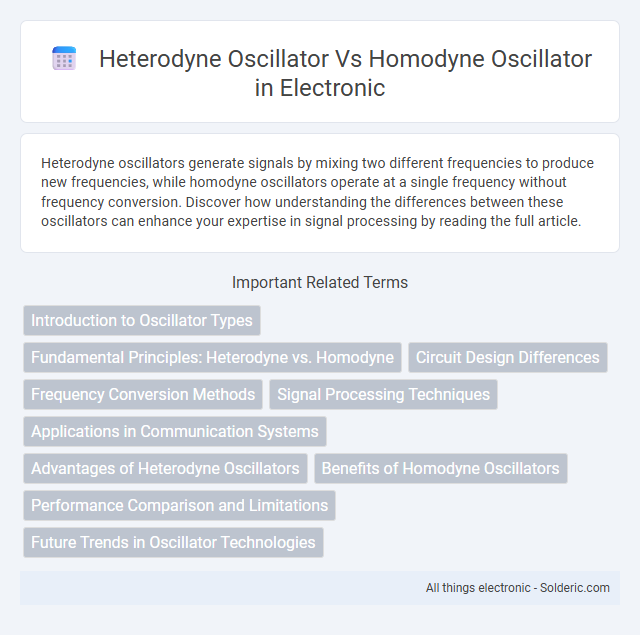Heterodyne oscillators generate signals by mixing two different frequencies to produce new frequencies, while homodyne oscillators operate at a single frequency without frequency conversion. Discover how understanding the differences between these oscillators can enhance your expertise in signal processing by reading the full article.
Comparison Table
| Feature | Heterodyne Oscillator | Homodyne Oscillator |
|---|---|---|
| Operating Principle | Generates beat frequency by mixing two different frequencies | Uses a single frequency, mixing input directly with itself |
| Frequency Output | Difference or sum of two input frequencies | Same as the input frequency, no frequency shift |
| Complexity | More complex due to multiple frequency sources | Simpler, with only one frequency source |
| Applications | Radio receivers, signal processing, frequency conversion | Radar, FMCW systems, phase detection |
| Signal Purity | Potential for more spurious signals and noise | Lower spurious components, cleaner output |
| Frequency Stability | Depends on stability of two oscillators | Depends on single oscillator stability, generally more stable |
Introduction to Oscillator Types
Heterodyne oscillators generate a signal by mixing two different frequencies to produce a beat frequency, which is commonly used in radio receivers for frequency conversion. Homodyne oscillators, also known as direct-conversion oscillators, operate at a single frequency matching the desired signal without frequency mixing, offering simpler design and lower phase noise. Your choice between heterodyne and homodyne types depends on factors like complexity, frequency stability, and application-specific signal processing needs.
Fundamental Principles: Heterodyne vs. Homodyne
Heterodyne oscillators operate by mixing two different frequencies to produce an intermediate frequency, enabling frequency translation and improved signal selectivity. Homodyne oscillators use a single frequency source to directly convert signals to baseband without frequency shifting, minimizing complexity and phase noise. The fundamental difference lies in the heterodyne method's frequency mixing versus the homodyne approach's direct conversion.
Circuit Design Differences
Heterodyne oscillators use two different frequencies to generate a beat frequency, requiring more complex circuits with mixers, local oscillators, and filters to combine signals and produce an intermediate frequency. Homodyne oscillators operate at a single frequency, simplifying circuit design by eliminating the need for frequency conversion components, making them more compact and easier to implement in applications like direct conversion receivers. Your choice in oscillator design will impact the circuit complexity, component count, and signal processing approach based on the desired frequency conversion method.
Frequency Conversion Methods
Heterodyne oscillators use frequency conversion by mixing two signals to produce a new frequency at the sum or difference of the original frequencies, enabling precise tuning and selectivity in communication systems. In contrast, homodyne oscillators generate a signal directly at the desired frequency without intermediate conversion stages, simplifying the design but potentially limiting frequency flexibility. Your choice depends on the required frequency accuracy and complexity of the application.
Signal Processing Techniques
Heterodyne oscillators utilize frequency mixing by combining two different frequencies to produce sum and difference signals, enabling better signal filtering and selectivity in signal processing techniques. Homodyne oscillators process signals at the same frequency, simplifying the architecture but often requiring more precise phase and amplitude control to minimize noise and distortion. Your choice between heterodyne and homodyne oscillators impacts the complexity and performance of signal demodulation and frequency conversion tasks.
Applications in Communication Systems
Heterodyne oscillators are widely used in communication systems for frequency conversion in superheterodyne receivers, enabling precise signal mixing and improved selectivity. Homodyne oscillators are preferred in direct conversion receivers, offering simpler architecture and reduced phase noise for applications like software-defined radios. Your choice between heterodyne and homodyne oscillators impacts the trade-off between complexity and performance in modern communication system designs.
Advantages of Heterodyne Oscillators
Heterodyne oscillators offer superior frequency stability and selectivity due to their ability to mix signals at different frequencies, minimizing phase noise and interference. They enable the generation of intermediate frequencies that improve signal processing accuracy in communication systems. This approach enhances the overall sensitivity and dynamic range compared to homodyne oscillators, making heterodyne designs preferable in radar and RF applications.
Benefits of Homodyne Oscillators
Homodyne oscillators provide superior signal purity by eliminating frequency mixing stages, leading to reduced phase noise and improved spectral efficiency. They facilitate direct conversion of RF signals to baseband, which simplifies circuit design and lowers power consumption in communication systems. The minimal frequency translation in homodyne architectures enhances linearity and reduces signal distortion compared to heterodyne oscillators.
Performance Comparison and Limitations
Heterodyne oscillators offer superior frequency stability and lower phase noise compared to homodyne oscillators, making them ideal for applications requiring precise signal generation. However, heterodyne designs are typically more complex and consume higher power, which can limit their use in compact or low-power devices. Homodyne oscillators provide simpler architectures and faster tuning capabilities but suffer from increased phase noise and reduced signal purity, restricting their effectiveness in high-performance communication systems.
Future Trends in Oscillator Technologies
Heterodyne oscillators, known for their frequency translation capabilities, are evolving with advances in integrated circuit design and low-noise components, enabling higher precision in communication systems. Homodyne oscillators, favored for their simplicity and phase stability, are benefiting from developments in digital signal processing and on-chip integration to enhance performance in radar and sensor applications. Emerging trends indicate a convergence where adaptive hybrid oscillators leverage both heterodyne and homodyne principles to optimize frequency accuracy and reduce phase noise in 5G, IoT, and quantum computing technologies.
heterodyne oscillator vs homodyne oscillator Infographic

 solderic.com
solderic.com